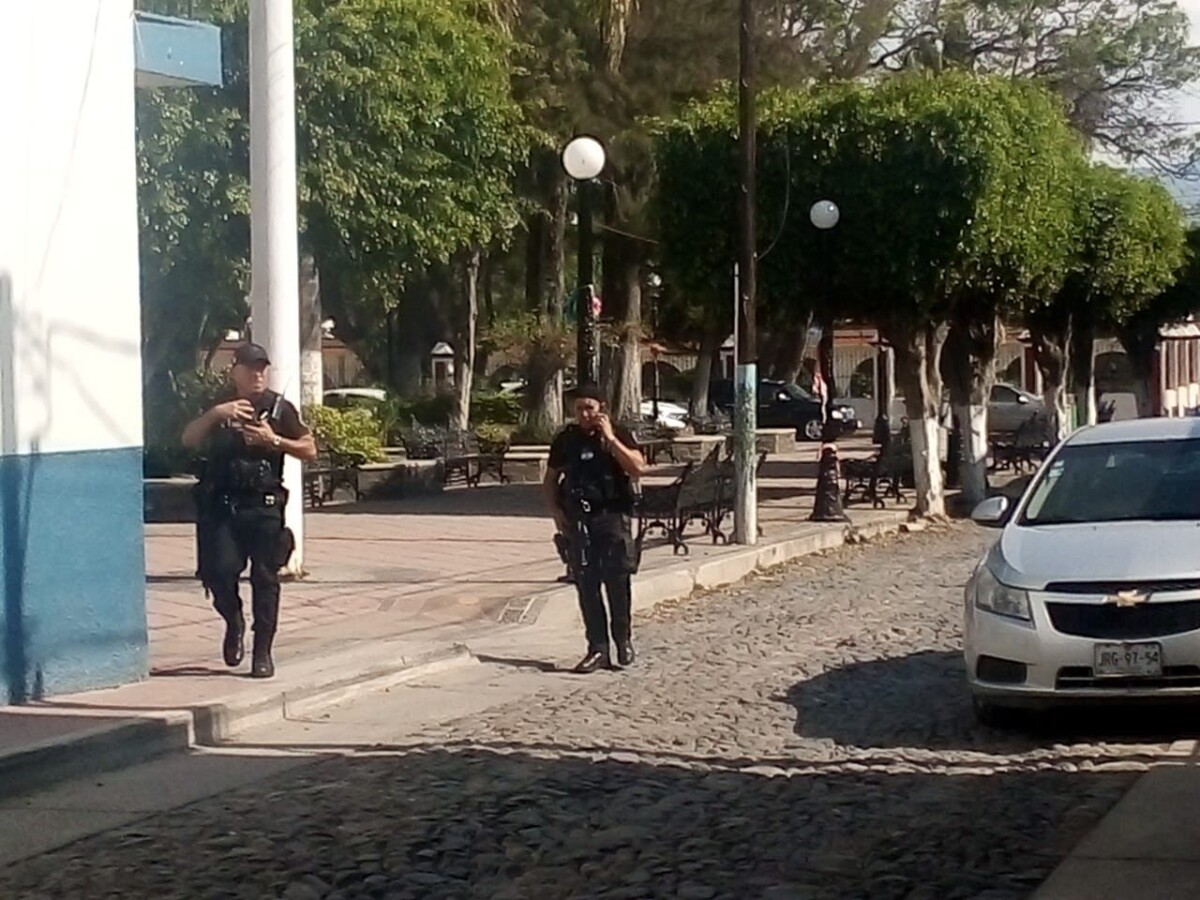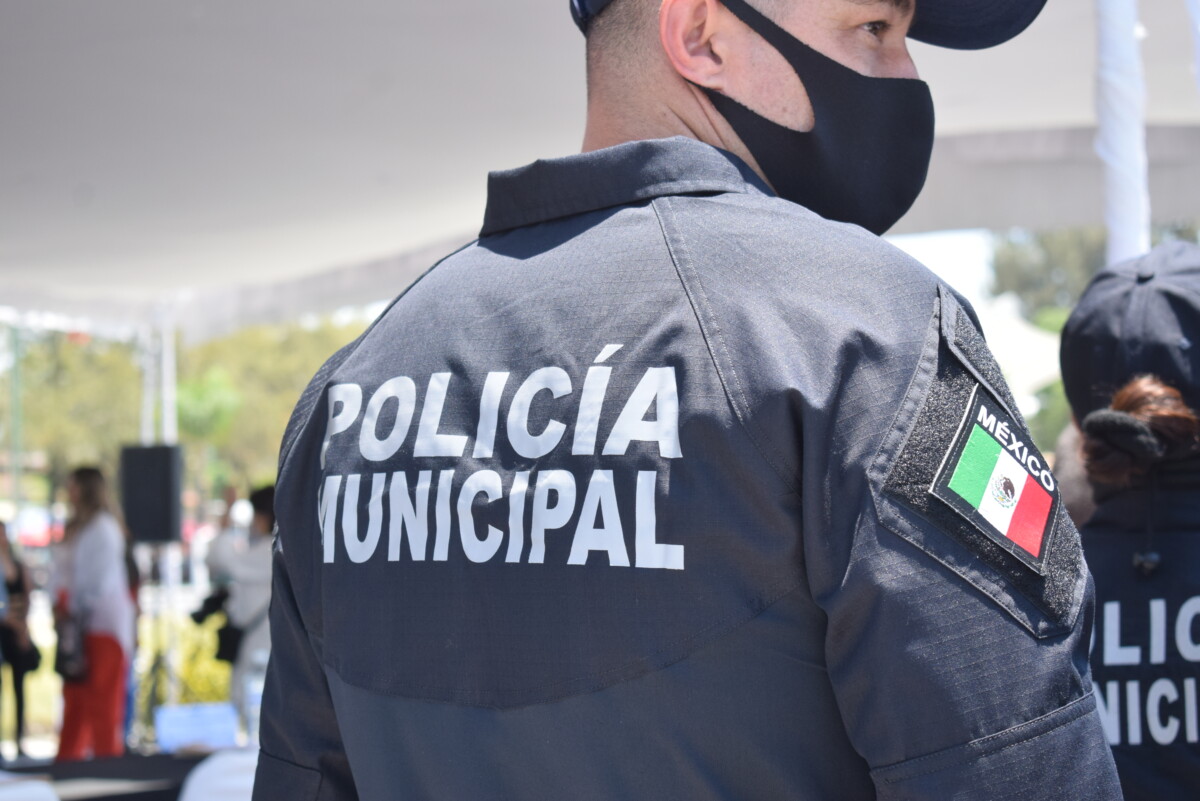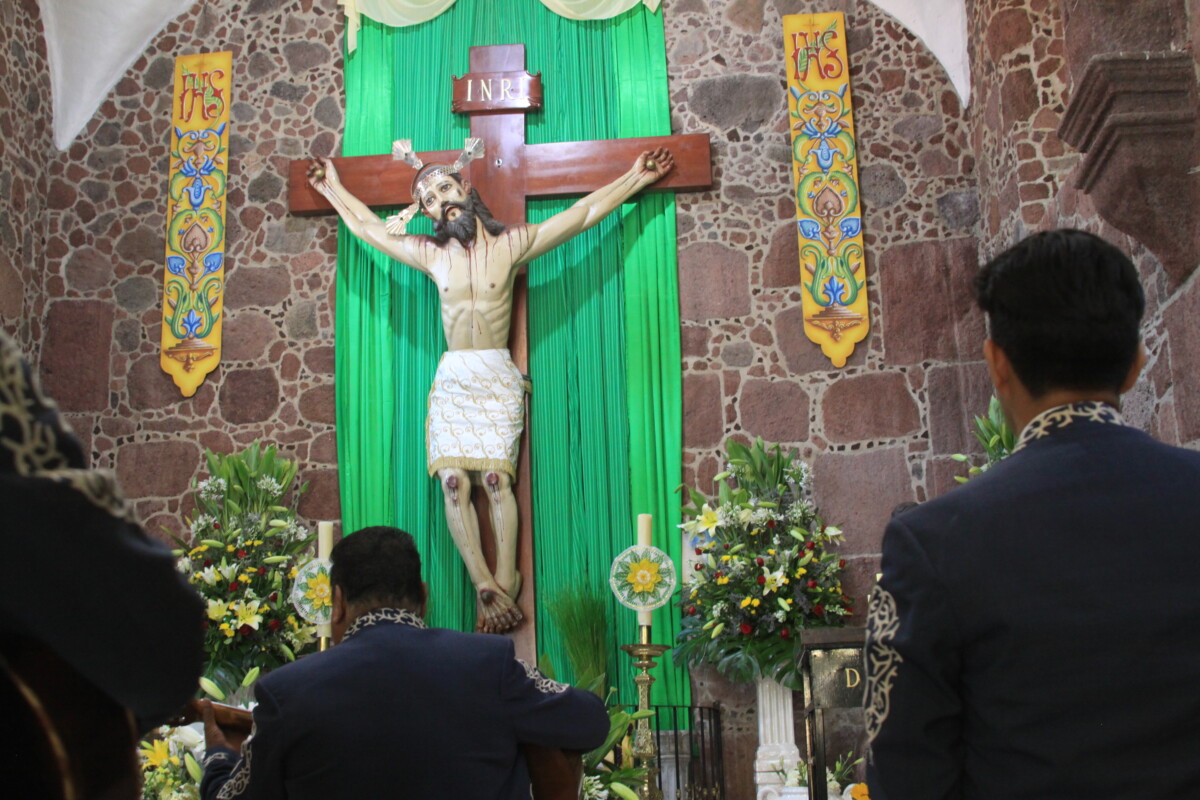gente
Evitan policías del Estado extorsión a familia de San Antonio Tlayacapan
El intento de extorsión ocurrió en la delegación de San Antonio Tlayacapan. Foto: Fiscalía.
Redacción.- Policías estatales que mantenían labores de patrullaje en la delegación de San Antonio Tlayacapan, en el municipio de Chapala, evitaron que una mujer fuera víctima de extorsión telefónica.
En su recorrido de vigilancia, los oficiales fueron abordados por un ciudadano, quien les reportó que su hermana atendía una llamada en la que le mencionaban que su hijo, un menor de 13 años, estaba privado de la libertad, además de exigirle el pago del rescate.

La familia afectada fue auxiliada por los oficiales en la localización del menor. Foto: Fiscalía.
De acuerdo al reporte difundido el 16 de mayo, los oficiales impidieron que la ciudadana efectuara la transferencia del dinero, informándole que se trataba de un posible intento de extorsión, al tiempo de emprender la búsqueda del menor para su pronta localización.
Minutos más tarde, se notificó a los uniformados sobre el arribo del adolescente a las inmediaciones de la Comisaría de Chapala, sitio al que acudieron para corroborar el hecho y verificar que se encontrara en óptimas condiciones de salud.
Luego de dar aviso sobre el caso al agente ministerial, fue la instancia municipal la encargada de regresar al menor a sus tutores.
Mathematics teacher arrested for alleged sexual abuse
The accused used physical and psychological violence to commit the abuse on repeated occasions. Photo: Prosecutor’s Office.
Editorial Staff.- Joshua A., who gave mathematics tutoring classes to a minor and allegedly sexually abused him, is facing criminal proceedings after the evidence provided against him by the Regional Special Prosecutor’s Office of District V based in Chapala.
The accused used physical and psychological violence; and the crime was allegedly committed on repeated occasions during the month of December 2021.
The last aggression occurred last April 24, in a home located in the Sabinos II neighborhood, in the municipality of Ixtlahuacán de los Membrillos, where said subject was carrying out school instruction to the victim.
Fearing that the accused would cause him greater harm, the victim kept silent; however, his brother found out about what happened, so he asked for help from his mother who, seeking access to justice, reported Joshua A.
The man was captured by agents of the Investigation Police of District V, who placed him at the disposal of a Supervisory Judge, who ordered him to stand trial, considering that the evidence was well-founded.
In addition, the judge ratified the request of the Public Prosecutor’s Office for Joshua A. to remain in preventive custody for one year, as a precautionary measure.
Translated by Kerry Watson
Do you have an RFC number? You will need one by July 1 if you live in México full or part-time
Appointment site of SAT for RFC cards.
Patrick O’Heffernan and Catherine-Claire Blythe. Do you have RFC number? Do you know if you do? Do you know what it is and that you need one? If the answer was no to any of there questions, read on.
The 2022 Tax Reform law passed by México now requires all citizens and legal residents (Permanente or Temporal) to have a Registro Federal de Contribuyentes (English: Federal taxpayer registration), known simply as an RFC number.
Plus, if you do business in México– even if you are only a customer of CFE or the water company or an internet provider – you need to fill out a form Constancia de Situación Fiscal (English: Proof of Fiscal/Tax Situation), which companies will soon be asking you for, if they have not already.
The RFC number and the Constancia de Situación Fiscal will be used by the Mexican government to track income and potential money laundering, but they will be used for many other things. Without an RFC number on your CFE bill, you won’t be able to sell your house or buy a car. Without an RFC number you won’t be able to open a bank account, and in some places, sign up for an internet service. So, you can’t blow it off.
This is a NEW REQUIREMENT FOR EVERYONE over the age of 18. who lives in México, full time or part time, whether or not you earn money in México. If you have a Temporal, a Permanente or a CURP, you must get an RFC number. Some people who have been here awhile may have been assigned an RFC number, so you should go online and check if you have one (see video link in the box).
If you don’t have an RFC, you have to actively go through a process to get one. The process is complicated, although you can hire someone to help you. But at some point you will have to personally visit a Mexican tax office so they can obtain biometric information of physiological characteristics like – but not limited to – fingerprints, iris patterns, or facial features.
The process for the Constancia de Situación Fiscal is much simpler and is done completely online, although you can hire someone to help you with it, too.You will need your RFC before filling out the Constancia de Situación Fiscal form.
You get an RFC number by physically showing up at an office of the Mexican equivalent of the American IRS, called the Sistema de Administración Tributaria (English: Tax Administration System), known by its initials, SAT. You must go in person, with your documents, so they can obtain your biometric information. And you have to do it by July 1,o 2022.
The nearest SAT office to Lakeside is in Guadalajara at Calz. Lázaro Cárdenas 2305, Las Torres, Guadalajara 44920.
For an RFC, you must get an appointment, which you can do online at http://citas.sat.gob.mx. You will need your CURP number (if you don’t know your CURP number, see below). Follow the steps on the site for a personal RFC (not a business RFC). If you don’t speak Spanish, use Google Translate to convert it to English or have a bi-lingual friend help you.
Fill in your info, follow the steps which will bring you to a calendar to use to schedule an appointment, but you will likely see a notice telling you there are no appointments available. If so, enter your email address to be put into a “virtual line” for the next available appointment. You will get an email confirming that you are in the virtual line and to monitor your email for your date. If you actually can make an appointment, take it because it may go away in a few seconds as thousands of people are trying to get them.
For the Constancia de Situación Fiscal, you can complete the process online, but you must have a RFC number first to fill out the Constancia de Situación Fiscal. Note that the Spanish word «Constancia» simply means “proof” in Spanish and there are other documents with the word «Constancia» on them . You need a document whose full title is Constancia de Situación Fiscal. You can go to satid.sat.gob.mx and fill out the correct form.
As this is a new process and involves taxes, whether or not you pay them in México, it might be helpful to check with an attorney or accountant who is familiar with Mexican tax law and the new RFC process.
While it may be convenient to use online translation to fill in the forms in English, SAT has not clarified if this is acceptable and a safer course may be to get help filling in the forms in Spanish until SAT clarifies this. Since the form for the Constancia de Situación Fiscal requires that you video yourself repeating some information in Spanish, you might want to get coaching in proper pronunciation.
Additionally, the Mexican government has not addressed a number of questions, such as a requirement for those with existing RFC umbers to update them with biometrics, or “snowbirds” with Temporals currently out of the country , an attorney or accountant can help you keep abreast of changes and new requirements.
For this story, Catherine-Claire Bly compiled the information for a Facebook post and Patrick O’Heffernan organized it in Semanario Laguna news style
(Sidebar box)
Videos to help you through the RFC process.
While this is all very complicated, there is help online in the form of videos by Qroo Paul of Two Expats in Mexico. Here ae the relevant videos:
RFC number explained and why you need one.
https://www.youtube.com/watch?v=D7_bMe2LUYU
How to find out if you I already have a valid, current RFC.
https://www.youtube.com/watch?v=0B9kUK37lQA
Making an appointment with SAT for an RFC, and paperwork/items to take with you.
https://www.youtube.com/watch?v=D7_bMe2LUYU
Step-by-step instructions on how to obtain a «Constancia de Situación Fiscal» online.
https://www.youtube.com/watch?v=eh2li1L6mA8
Finding your CURP alpha/number if you don’t know it.
Being an entrepreneur and a mother is a challenge
Marani Soto Alarcón and her daughter Emilia, for whom the shop is named. Photo: Sofía Medeles.
Sofía Medeles (Chapala).- Despite being young, Ajijic resident Marani Soto Alarcón has achieved a balance between being an entrepreneur and fulfilling her motherly duties while following her vocation as a florist.
Marani is 28 and was born in Las Trojes, Jocotepec. She left her hometown to look for new opportunities, and eight years ago she arrived in Ajijic.
Soto Alarcón said she has always practiced entrepreneurship, from selling shoes in her hometown, to being a beautician, with food businesses and in her current and favorite business, the flower shop «Las Plantas de Emilia,» named in honor of her daughter.
“When I came to Ajijic, I worked in places where I was not as comfortable,” she said. “Since I was a child, I have had a taste for plants, a connection, though it was something I saw as a hobby, not as a way of life.» She recalled that a television program helped her get rid of her fear, and she decided to set up the business she loves so much.
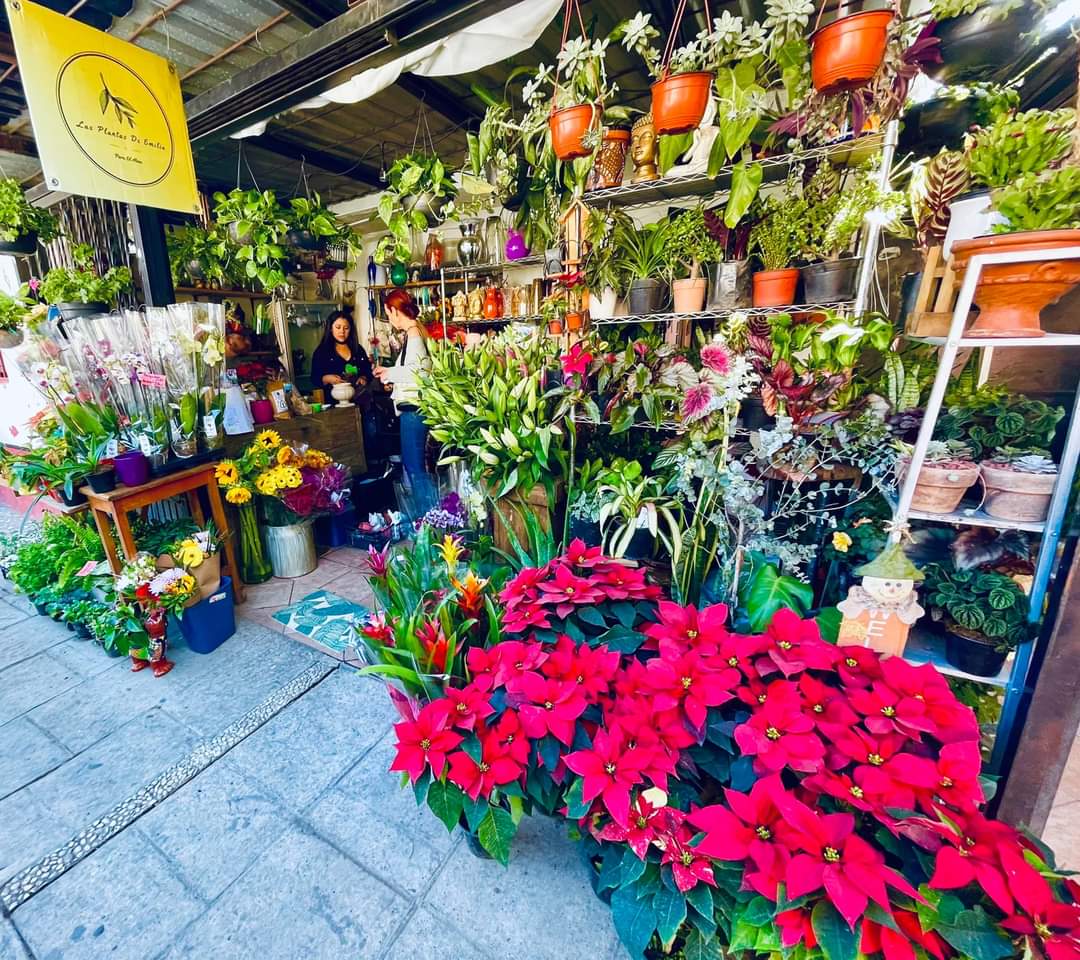
The flower shop is at Carretera Oriente #18, Ajijic Centro. Photo: Las Plantas de Emilia.
Presenting a revolutionary proposal to traditional flower shops, fused with the sale of plants and accessories for them, Marani opened her first flower shop, motivated by the desire to have economic stability, both for her and her daughter Emilia.
“I found the perfect formula to work and live from what I like,” she said. “I started with nothing, with gifted furniture and a loan of 2,000 pesos that I still haven’t paid to my mom… but it’s nice to see the evolution of the business, and how it has been accepted and valued by customers.”
As for the challenge of being a mom, while holding the growth of her business hand in hand, she describes it as easy. She can manage her time and spend it with her daughter, fulfilling the maternal life as well as the professional life.
“It’s hard to have chosen a profession where holidays are the days with the most work,” Marani said. “One of the busiest days is Mother’s Day, and this is the first year I have seen my daughter. Previously I would see her the next day, but this is a sign that the business is growing and is on the right track.”
Despite her achievements, her professional path has not stopped. She says there are plans to expand Las Plantas de Emilia. Today, she has a branch in downtown Ajijic and one in the San Antonio Tlayacapan delegation, which she plans to move to a larger site within the same town. She may also open a flower warehouse and become a distributor, and there is an opportunity for a high-end line of floral arrangements, also called Boutique de Flores.
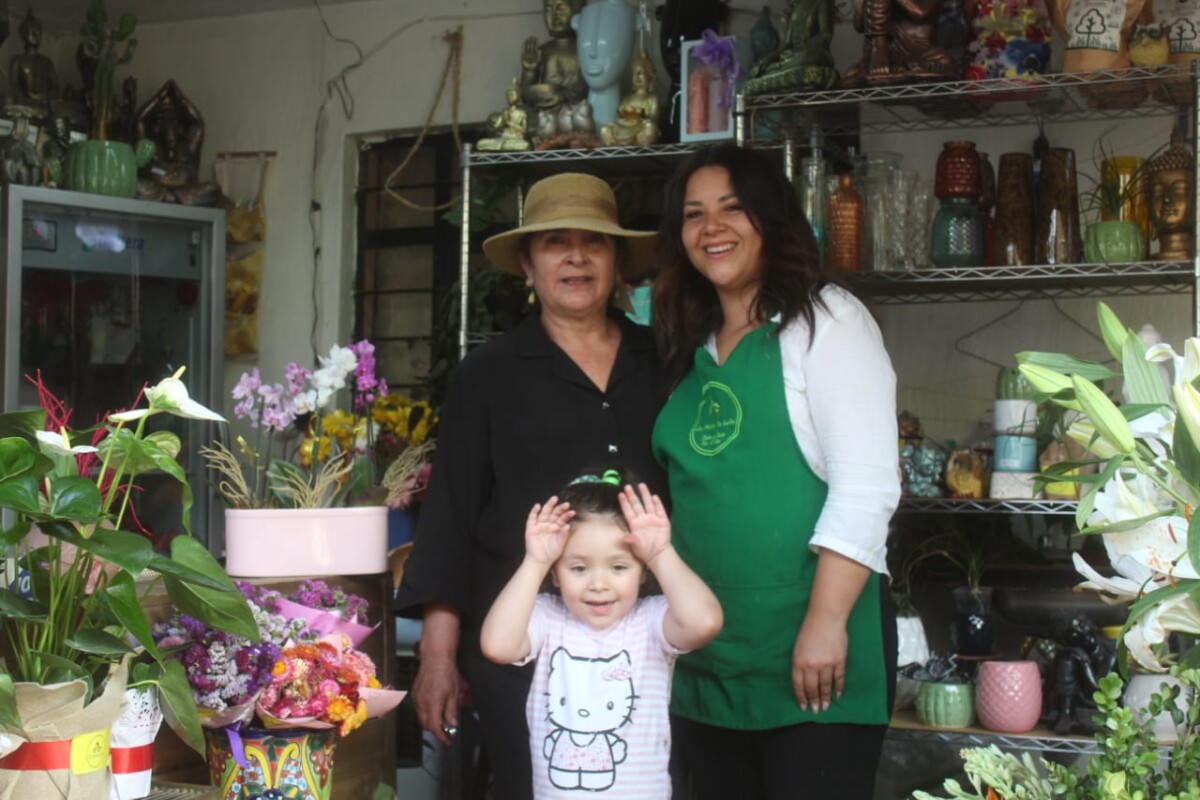
Marani with her mother and daughter. Photo: Sofia Medeles.
“I plan to continue educating myself, taking courses, because it is a business that renews itself, has trends, and needs innovation,” she said. “This is a town used to the traditional, but thanks to the foreign influence, it has become more open to new designs and ways of using flowers.”
Marani offered advice, both to young people and to enterprising mothers. First, lose your fear because it does not get you anywhere – it gets you stuck. Second, find your vocation and do things with pleasure. Third, and more focused on mothers, is to find trusted support to take care of the children.
“At the beginning, the business absorbs your time, so it’s good to have support,” she said. “If you have the potential and the desire, get rid of your fear. Approach people, knock on doors and be kind when you have your business.”
Marani reflected that there is no formula for success, since everyone must follow the path their heart and their decisions indicate. She invited people to visit her at the Ajijic branch, Carretera Oriente #18, or the San Antonio branch on Colón #117. She can satisfy a variety of tastes and work within any budget.
Translated by Mike Rogers
Holy Week and Easter holiday period results in one dead, two arrested, three injured, 20 road accidents
Municipal Public Security officers. Photo: Jazmín Stengel.
Jazmín Stengel (Chapala).- During the Holy Week and Easter holiday period from April 9 to 24, there was one death, two arrests, three injuries, 20 road accidents, 87 infractions and two closed bars. This balance was presented by the municipality based on the Security Operation Joyful Holidays in Chapala.
A 42-year-old man from El Salto lost his life after he overturned his ATV on the road from San Nicolás de Ibarra to Atotonilquillo on the evening of April 16. No details are known about the accident since it was reported to the Fire Department and Civil Protection by citizens who were passing by.
The first arrest was the result of a serious accident between a car and a motorcycle, in which the motorcyclist was seriously injured and was treated by the Chapala Red Cross and later transferred to a hospital. The driver of the car was arrested.
The second person arrested was due to traffic officers who were looking for the driver of a vehicle that was blocking the road and who tried to flee in a car while inebriated, stated the director of Mobility Chapala, Moisés Ochoa Urquieta.
In another incident, two people were injured in an accident between cars in which both drivers were injured and taken to hospitals for medical attention. The Public Prosecutor’s Office did not arrest either of them, specified Ochoa Urquieta.
In total, 20 road accidents were reported during the holiday period by the Chapala traffic department, however, most were only material losses.
The department’s report also includes 87 infractions issued from April 9 to 24; 15 complaints from the community, and two vehicles stopped for blocking parking lots or interrupting the flow of traffic. This is in addition to road assistance that was required for three hours due to demonstrations on April 14.
The Regulations Department also reported the closure of two stalls on the Chapala boardwalk due to a dispute over space between the two owners, 25 warnings, 15 summonses and 20 visit orders were issued to supervise different commercial activities.
During the operation, the departments of Mobility, Public Safety, Fire and Civil Protection, Regulations and Tourism were involved. In addition to the heads of each department, 60 police officers, 17 traffic officers, 19 inspectors and 42 firefighters participated throughout the municipality of Chapala.
Translated by Sydney Metrick
Destacan corredores de Ajijic en competencia nacional
(De Izq. a Der.) Filiberto Pérez Vega, Nadia Vega y José González Valenzuela. Foto: Sofía Medeles.
Sofía Medeles.- Tres deportistas de Ajijic del grupo de corredores de montaña “Team Jou”, lograron destacar en la competencia “Ultra Cerro Rojo” en Tlatlauquitepec, Puebla, que se realizó el pasado 30 abril.
Se trata de José “Jou” Valenzuela, Filiberto Pérez Vega y Nadia Vega, quienes corrieron en la categoría libre, en diferente kilometraje; Jou en los 50 km alcanzando el noveno puesto, Nadia en 15 km logrando el sexto lugar y Filiberto en los 30 km posicionándose en el número 15.
Tanto Filiberto como José se dijeron contentos con esta experiencia, pese a que la calificaron como una carrera “pesada”. Para Nadia, esta competencia fue la segunda en la que participa fuera de Jalisco, por lo que compartió que le pareció increíble salir y conocer estos lugares que calificó como hermosos.
“Por mi lesión, se me dificultó un poco la carrera, la terminé por orgullo. En la ruta me apoyaron y me dieron una pastilla para seguir. Aunque en mi caso no logré el objetivo y me sentí frustrado, eso me motiva para seguir y ser mejor en las próximas carreras”, comentó Jou Valenzuela.
Los tres maratonistas de montaña coincidieron en que seguirán corriendo en carreras fuera del pueblo, y que se sienten muy motivados, además de agradecidos por el apoyo que les ha brindado la gente de Ajijic.
Respecto a cómo se selecciona quienes representarán al “Team Jou” en este tipo de carreras, Valenzuela mencionó que los eligen por “las ganas” que les echan a los entrenamientos.
Asimismo, invitó a quien quiera formar parte de su equipo, solo hace falta contactarlo por medio de su página de Facebook “Jou Valenzuela” para que les pueda proporcionar información de las reuniones.
San Juan Cosalá residents celebrate Cross Day
San Juan Cosalá delegation crosses were decorated with floral arrangements.
Alma Serrano (San Juan Cosalá).- Traditionally, parishioners go up to the cross on a hill to pay their respects or simply as an act of faith. On the way, some pick up stones. When they arrive at their destination, they leave the stones next to the cross as a symbol of offering. Others leave money, objects, written notes and even food.
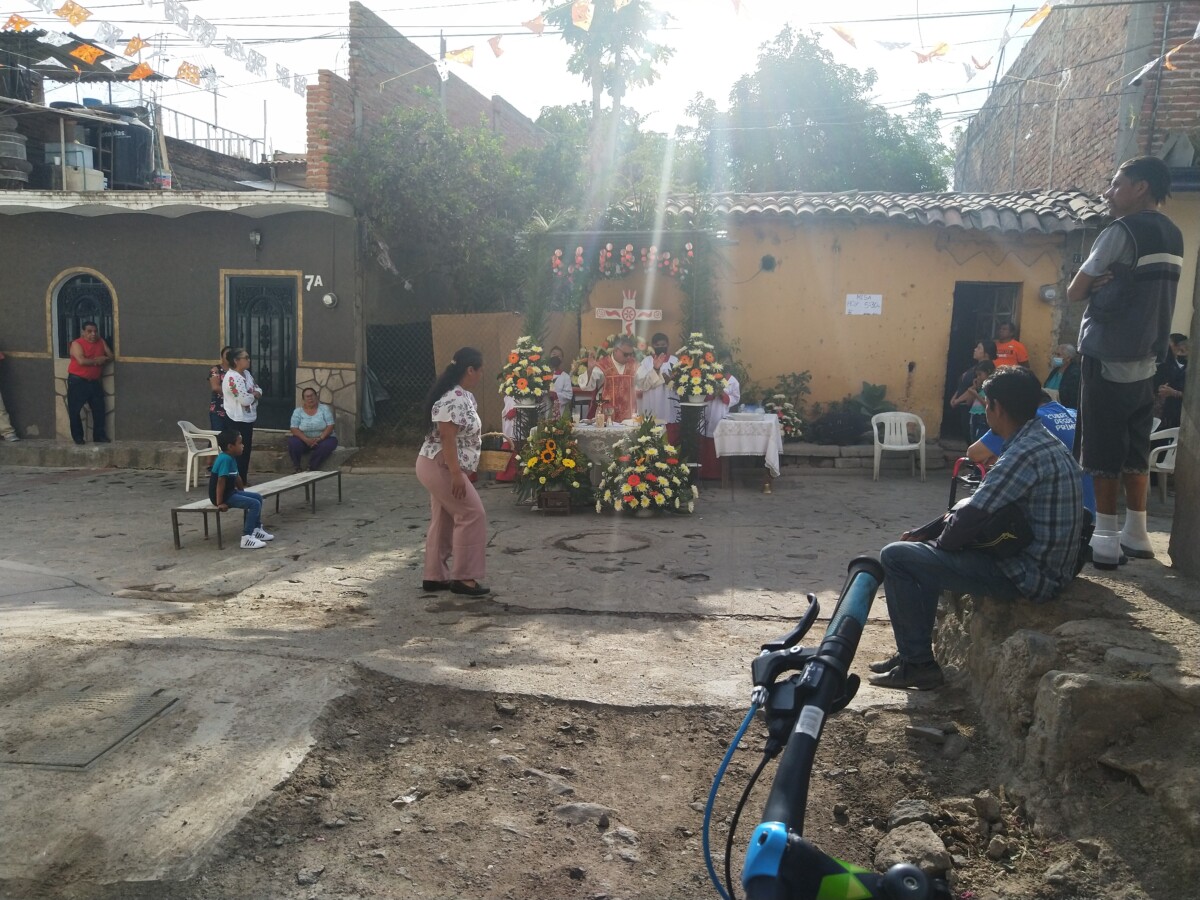
The cross on Morelos Street was decorated with composure and floral arrangements. Photo: Alma Serrano.
In the town, the crosses were decorated with flowers and colorful composure. Some are on La Paz, Morelos and Vicente Guerrero north streets. The general population, especially the elderly, visited the crosses near their homes to participate in the Eucharistic celebrations and prayers.
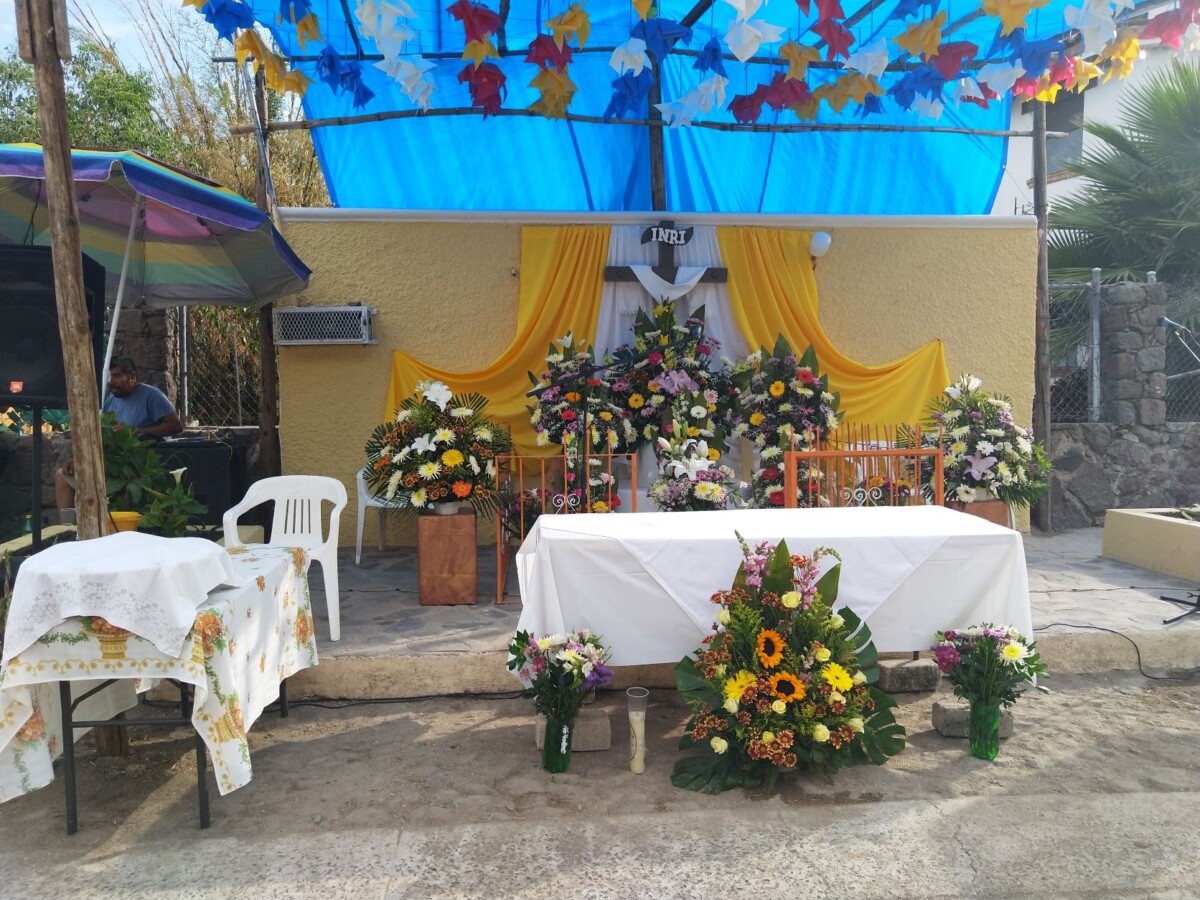
At the cross on north Vicente Guerrero street, the neighbors celebrated with a mass. Photo: Alma Serrano.
“Because of my legs, I can no longer go to the cross on the hill,” said a 63-year-old San Juan Cosalá resident. “It is very tiring to climb, so I just come like today, but here. It is nice and one comes to ask things to the Holy Cross.”
This day is also to remember the dignified and invaluable work of the masons, who honor the date by erecting a cross decorated with paper flowers. “I have been a mason since I was 13 years old,” said a 57-year-old worker. “We build homes, and it is an important and dignified job.”
Translated by Mike Rogers
Lakeside Chronicles
The traditional Las Mañanitas are sung by the mariachi in the festival of the Lord of Huaje.
By: María del Refugio Reynozo Medina
NOTE. Just as Mexican Catholics recognize many representations of “la Virgen,” they also recognize many representations of Jesus Christ. Usually these are depicted with a sculpted figure, sometimes of great antiquity and value, often dating back to the 1500s or 1600s when Spain was establishing the church here. These representations have their own names and their own celebration days, and are often credited with performing miracles on behalf of the faithful. This article refers to the celebration for “el Señor del Huaje,” a large figure of the crucified Christ made of the wood of the “huaje” or tamarind tree, which is celebrated with a festival and procession on the first Sunday in May each year.
The streets of Jocotepec are still in darkness. It is about 5:30 in the morning and the orange flowers and green foliage of the flame-red tabachine trees at the entrance of the temple look grayish.
About a hundred people are already gathered inside and outside the temple, under the leafy trees. Dances are being prepared and the brass band is playing. Steaming pots rest in their stands. Chocolate, cinnamon and tamarind atole (a hot cornflour drink) awaits the faithful who gather at the temple of the Señor del Huaje, for his feast.
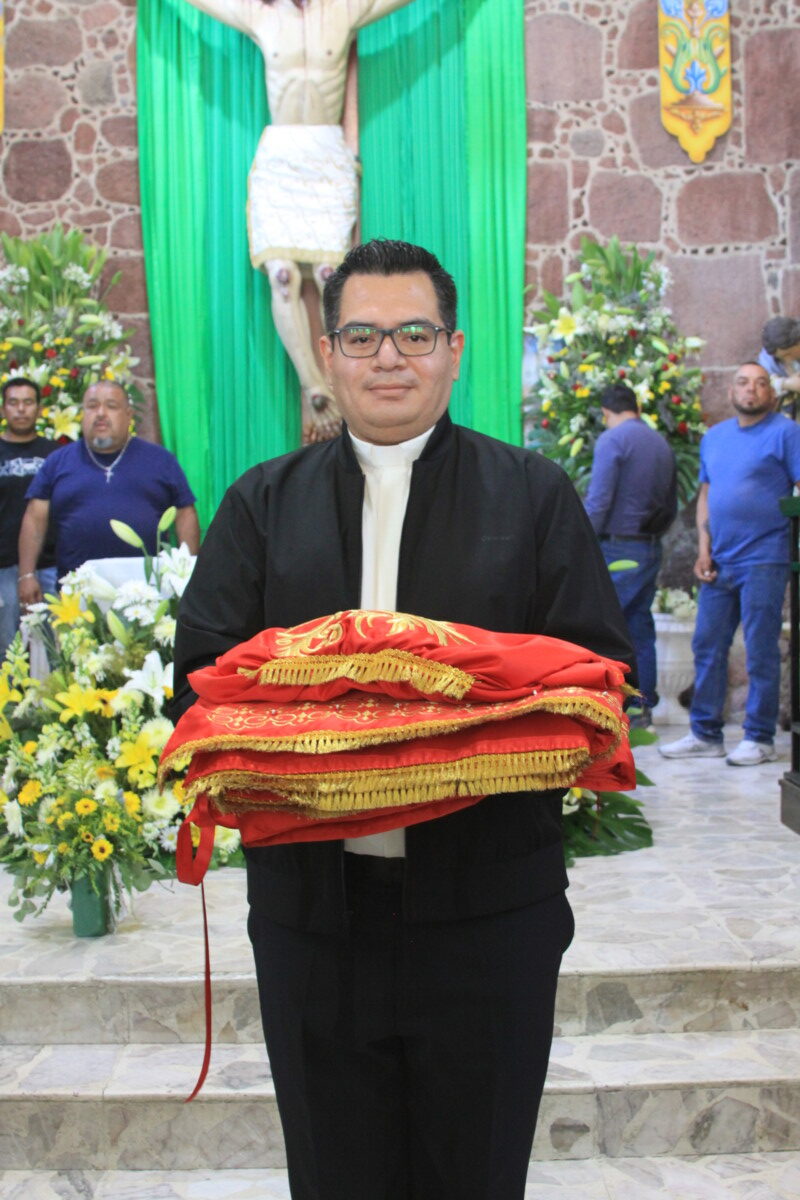
Father Eduardo Garcia Orta with the new cendal or loincloth that was presented for the festival of the Lord of the Huaje. In the words of Father Lalo, the fiery red symbolizes the spilled blood embroidered with golden threads as a symbol of royalty.
The band is playing a popular dancing song, El Mono de Alambre (The Wire Monkey). The men of the band sing. The bells ring the second call for the six o’clock mass and Father Mario Fernando Sandoval Varela comes out of the temple to welcome the cargueros (the men who will be carrying the figure of the Señor del Huaje in the procession).
“How about the music,» he says. And El Mono de Alambre is interrupted by the chants of a procession.
“Long live my Christ, long live my King,” some women sing, and the band stops.
Soon the San Cristobal Band arrives and intones the traditional Las Mañanitas, followed by waltzes and pasodobles dances, which permeate the Eucharistic celebration.
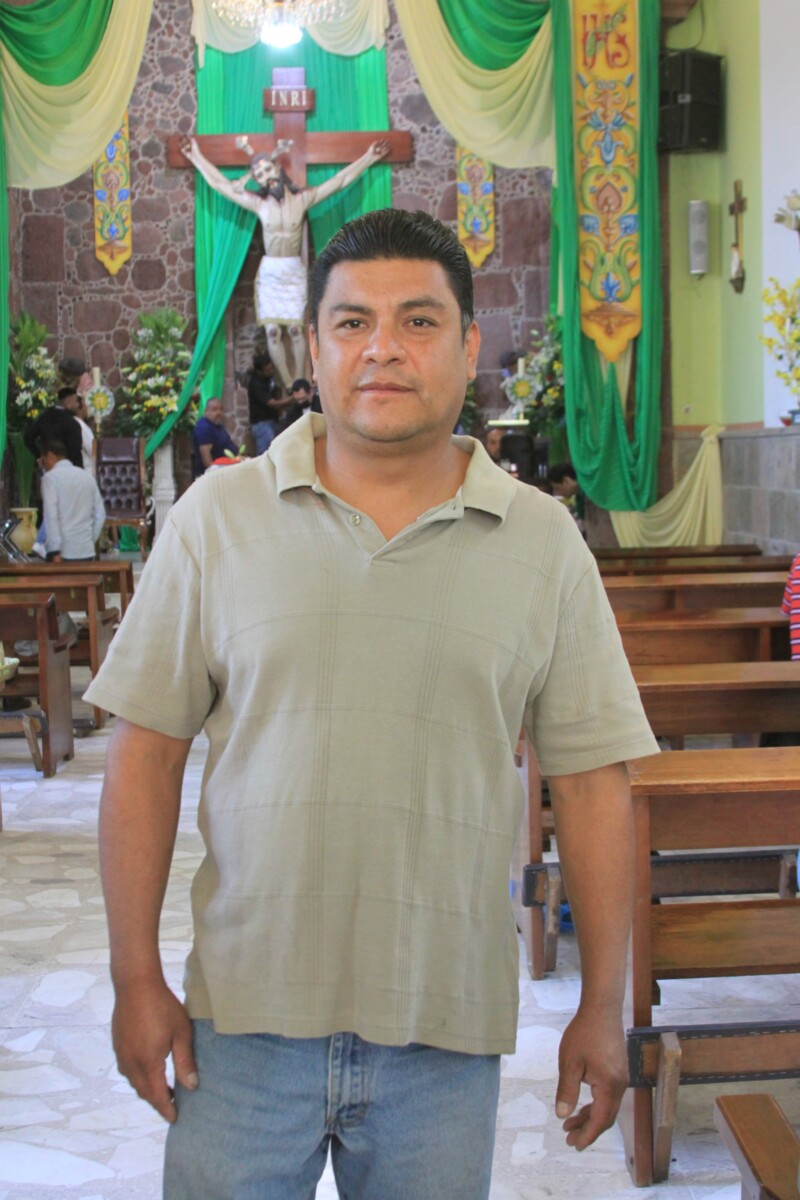
Carlos Mendo has been responsible for the honor guard of the Lord of Huaje for ten years.
At the end of the mass, a man reads a list of the various expenses of the festival: the music, the dawn ceremony, decorated candles, dances, dinner for the musicians and the castillo or fireworks tower. He names the families who will assume the expenses. Many of them are from the Nextipac neighborhood
At the exit of mass, they begin to distribute the drinks and the dancers execute their movements to the sound of the drum and the caracol, a prehispanic musical instrument like a trumpet made of shell or ceramic.
Today is expected the visit of Father Eduardo Garcia Orta who spent three years in the community of Jocotepec and still retains the affection for these lands and the veneration for the Lord of the Huaje.
Father «Lalo» as the community calls him, is on his way with a very valuable cendal, a beautifully decorated loincloth that will be wrapped around the image of Christ to be premiered by the Señor del Huaje in his feast. Some representatives of the honor guard gather and wait eagerly for its arrival. «They say that this loincloth has golden threads» a discreet and festive voice is heard. There is much excitement to see it and to welcome the priest.
Upon his arrival, Father Lalo is received with signs of affection. They congregate at the altar and everyone approaches to see the loincloth, which is bright red with gold embroidery.
To carry out the change of the loincloth, putting the new one in place of the current one, the men remain in the enclosure and the women wait outside. A woman who accompanies me in the wait says, “These are men’s duties; women have no business being there.”
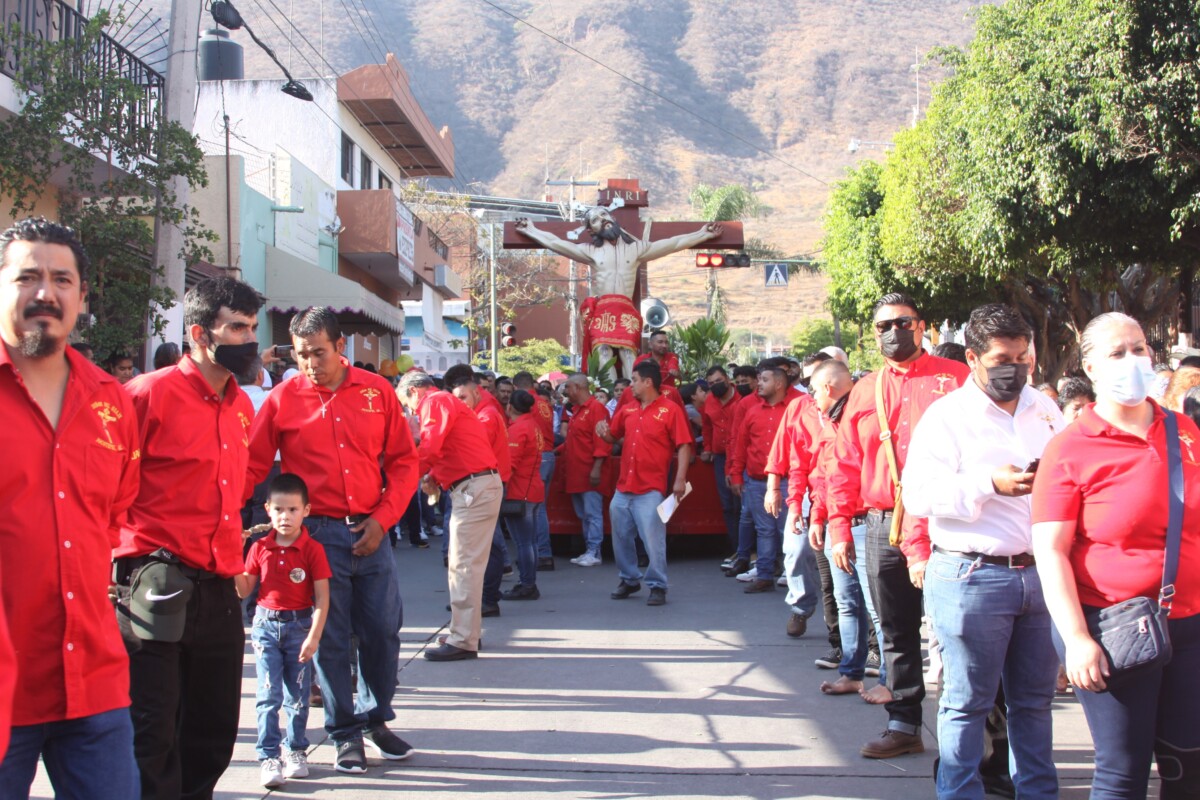
The members of the guard of honor wear bright red shirts to guard the Lord of the Huaje.
Carlos Mendo is the main person in charge. For ten years, he has overseen the honor guard. It is made up of about a hundred people, mostly men and a few recently integrated women. He was questioned by some parishioners for having allowed access to women.
“God doesn’t say you don’t or you do,» he responded confidently.
Mr. Roberto Mendo, Carlos’s father, was the last person in charge and left the position to his son.
It is a great responsibility, says Carlos, because it means taking care not only of the image of a beloved Christ, but also of a piece of historical artistic value. The last restoration cost 140,000 pesos (about US$7,000), which were raised with donations from the community.
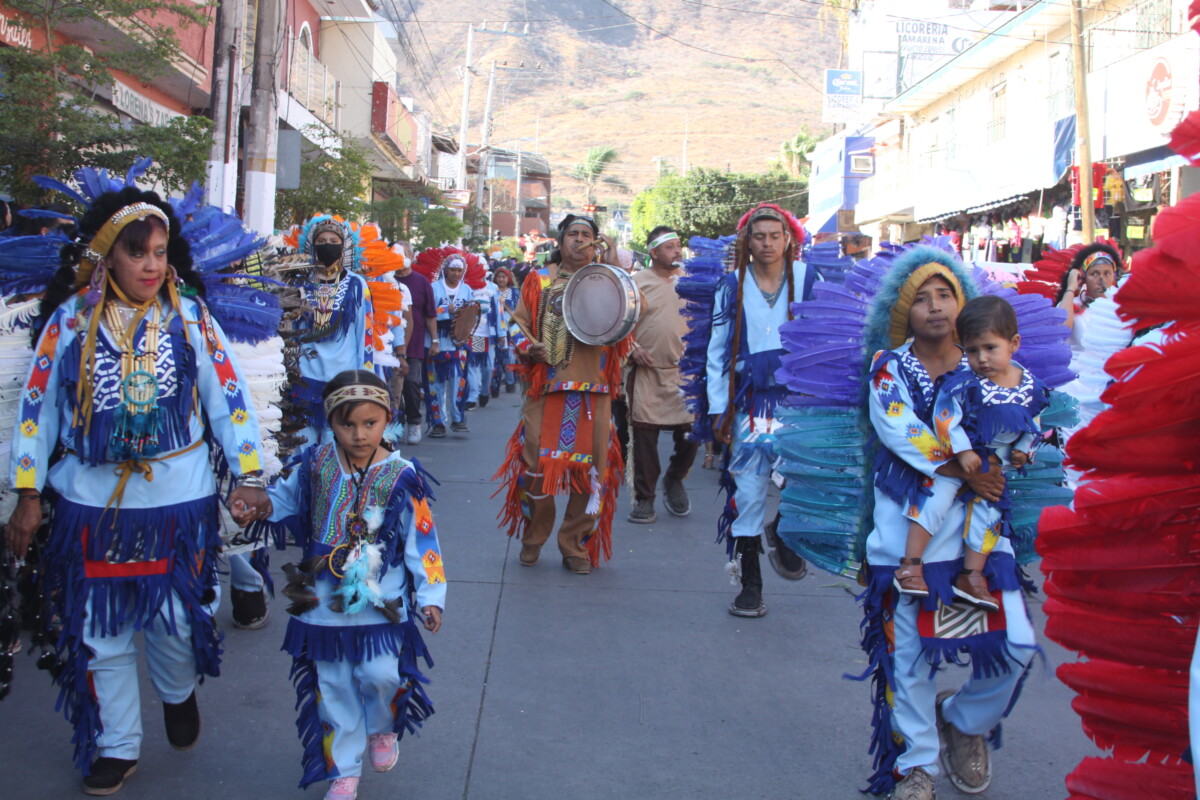
The dances are present in the procession in which children and adults participate.
It is a difficult responsibility, but it is also a blessing. «Now I only ask for work and health,” he said.
Víctor, a member of the honor guard, shares a testimony. His wife was sick for a couple of months, having inexplicably lost the mobility of her body, during which time she remained in bed in a lot of pain. They went to several doctors and his wife’s health did not improve. One morning, she told him, “I dreamed of the Lord of the Huaje.”
In the dream, the Lord of the Huaje told her to «drink from that water,» pointing to a small puddle next to him. The woman asked to be taken to the temple with the figure of the crucified Christ. When she was in front of the altar there was some water on the floor, so she brought her lips close and implored for her health.
That day she walked out of the temple, healthy. From then on, both asked to be part of the honor guard.
On the first Sunday of May, the day denoted for this celebration, the procession is almost the last ceremony of the day. Before that, mariachi musicians coincide with the band with their blue shirts and at least five groups of dancers. Colorful plumage abounds to the beat of the drum.
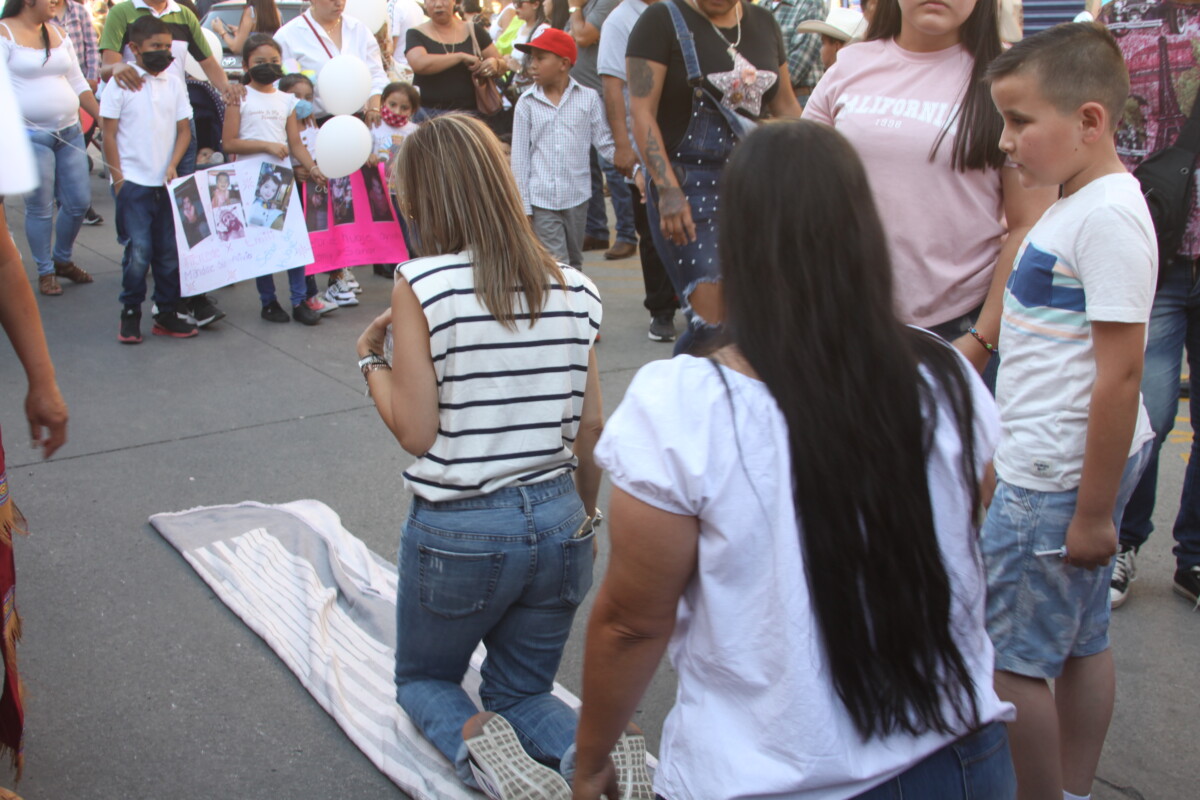
Many parishioners go to meet the icon on their knees.
There are lines of people kneeling to approach the crucified figure to fulfill a request or ask for a favor.
The route of a couple of hours is a mosaic of dancers with multicolored feathers and costumes, musicians with their polished costumes and the honor guard with their bright red shirts.
The sound of the drums announces the approach of the procession. As it passes, the figure of the crucified Christ, almost three meters high, draws sighs and tears.
In a loudspeaker, the voice of a woman prays and sings, “There are eyes that, if they look at me, make my soul tremble with love, they are such beautiful eyes…”
The Lord of the Huaje is carried on a special platform driven by a man. He advances, standing out among the crowd with his gaze towards the sky, towards the mountains, towards the faithful who sometimes look into his eyes. “Because He lives,” says a woman next to me, ecstatic with fervor.
Translated by Sandy Britton
Man arrested in Chapala for alleged child sex abuse
The Regional Prosecutor’s Office served an arrest warrant against Joshua A. for suspicion in the crime of aggravated child sexual abuse, and corruption of minors.
Investigations by the Investigative Police division led to the locating, and arrest of this man. He was arrested at the intersection of Isla del Presidio and Los Maestros, in the Gastronómica neighborhood, in Chapala municipality. Joshua A. is allegedly connected to the sexual assault of a child reported earlier this year.
Translated by Amy Esperanto
Runners from Ajijic stand out in national competition
From left to right Filiberto Pérez Vega, Nadia Vega and José González Valenzuela. Photo: Sofía Medeles
Sofía Medeles (Ajijic).- Three Ajijic runners from the «Team Jou,» mountain runners shined in the competition «Ultra Cerro Rojo» in Tlatlauquitepec, Puebla, which took place on April 30.
They are José «Jou» Valenzuela, Filiberto Pérez Vega and Nadia Vega, who ran in the free category, covering different distances: Jou competed in the 50 km race, reaching ninth place, Nadia in the 15 km race, achieving sixth place and Filiberto in the 30 km race, positioning himself in fifteenth place.
Both Filiberto and José said they were happy with the experience, even though they described it as a «hard» race. For Nadia, this competition is the second in which she has participated outside of Jalisco. She shared that she found it incredible to go out and see these places that she described as beautiful.
«Because of my injury, the race was a little difficult for me, but I finished it out of pride. On the route, organizers supported me and gave me a pill for the pain to keep me going. Although I did not reach the goal I had set for myself and felt frustrated, it motivates me to continue and to do better in the next races,» said Jou Valenzuela.
The three mountain marathoners agreed that they will continue running in races outside of their hometown, and that they feel very motivated – as well as grateful – for the support that the people of Ajijic have given them.
When asked about how runners are selected to represent «Team Jou» in this type of race, Valenzuela said that they are chosen for «the commitment» they put into their training.
He also invited anyone who wants to be part of his team to contact him through his Facebook page, «Jou Valenzuela» so that he can provide them with information about the group.
Translated by Rebecca Zittle
© 2016. Todos los derechos reservados. Semanario de la Ribera de Chapala
